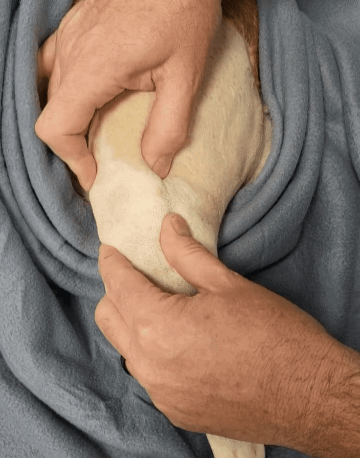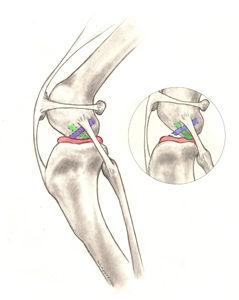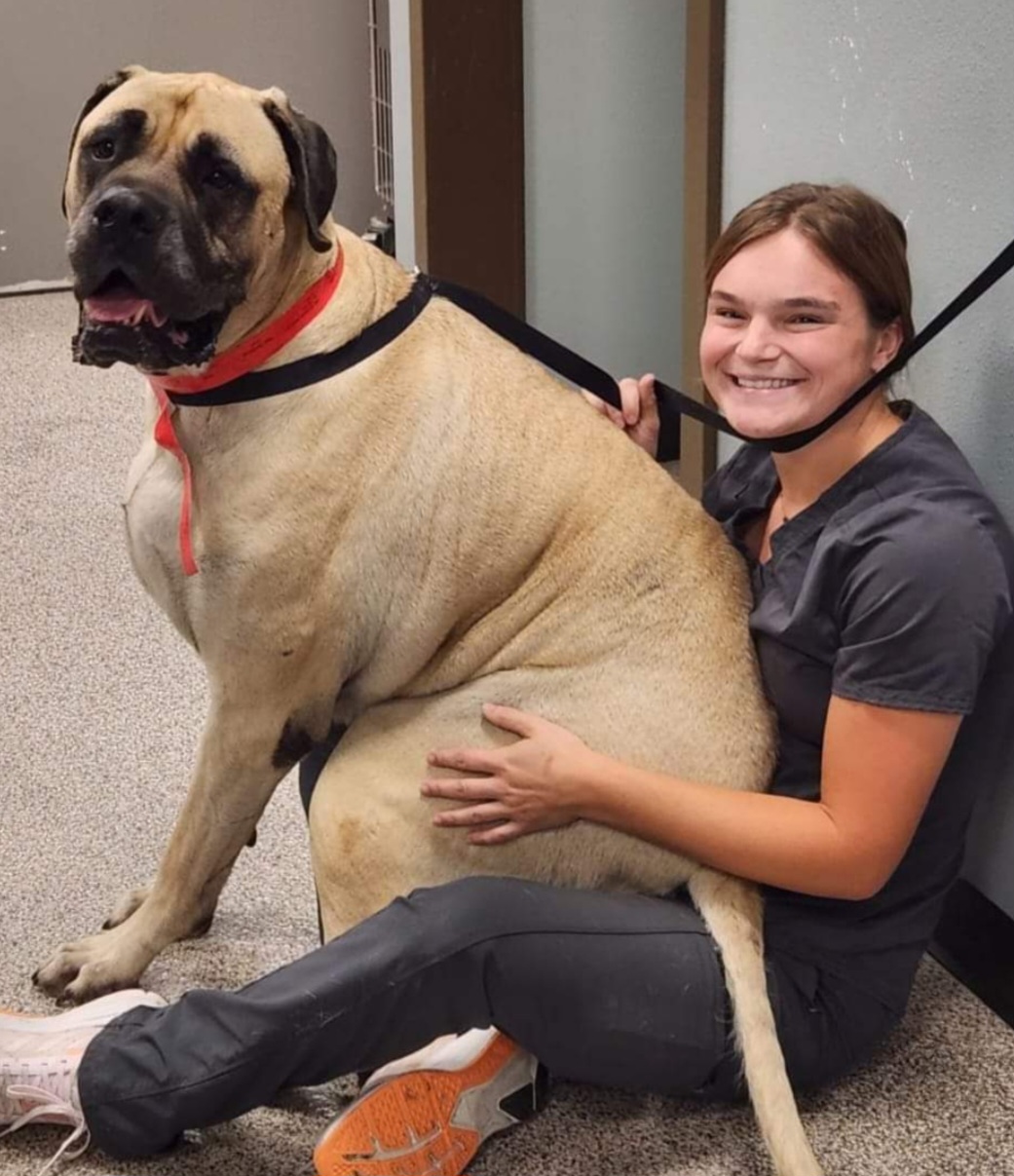Easily the most common orthopedic injury in dogs, the cranial cruciate ligament (or CCL) is a very important stabilizer in the stifle (knee) joint in the rear leg. Many are familiar with the anterior cruciate ligament (or ACL) in people which is the same ligament but we just call it by a different name in animals. Injury of the CCL, often called cranial cruciate ligament disease (or CCLD), is a painful condition that leads to pain, arthritis, and lameness in dogs.
Cranial Cruciate Disease occurs in dogs of all breeds and sizes (and sometimes in cats as well). Some breeds are more commonly affected. Although any dog can be affected, the most common breeds affected include Labrador Retrievers, Chesapeake Bay Retrievers, Saint Bernards, Newfoundlands, Rottweilers, Akitas, and  Staffordshire Terriers. Dogs that are overweight or otherwise not at a good level of physical fitness are at a much higher risk of CCLD than regularly exercising, fit, and trim dogs.
Staffordshire Terriers. Dogs that are overweight or otherwise not at a good level of physical fitness are at a much higher risk of CCLD than regularly exercising, fit, and trim dogs.
CCL injury can range from a partial tear to a complete rupture of the ligament. Many cases are progressive and a “strained” CCL will often eventually rupture. With injury, there is usually a severe and sudden lameness of a back leg that then may appear to improve but never gets fully better. Affected dogs will often limp, lose muscle mass in the affected leg, and no longer sit with the injured leg neatly tucked squarely.
If your dog is lame for more than one day or is in obvious pain, seek out a veterinarian. There are many signs that a veterinarian can test for to diagnose CCLD. Tibial thrust tests and cranial drawer tests will often allow a veterinarian to diagnose the injury. Many times, a sedated orthopedic examination and X-rays will be needed. In some cases, advanced imaging like MRI may be necessary.
Once diagnosed, the treatment for cranial cruciate disease is surgery. Ruptured CCLs WILL NOT HEAL. Untreated dogs will become arthritic and will suffer lameness for the rest of their lives. It is extremely common for a dog to end up rupturing the CCL in the other knee. If your dog has been diagnosed with a CCL tear, schedule to meet with a veterinarian skilled in dog ACL surgery. “Let’s try some pain meds and wait and see how he does” or “Let’s try a brace” will not work and only advances the arthritis that will set in.
There are three primary surgeries (with several additional variations) that are considered excellent treatments for cranial cruciate disease rupture. In the United States, the most well-known is tibial plateau leveling osteotomy (TPLO) followed by tibial tuberosity advancement (TTA). Cranial closing wedge osteotomy (CWO) is more commonly performed by our European counterparts. During each of these procedures, an osteotomy (a cut in the bone) is performed and the anatomy of the tibia is altered to eliminate the need for a CCL. These provide permanent solutions that gives affected dogs a normal life.
the most well-known is tibial plateau leveling osteotomy (TPLO) followed by tibial tuberosity advancement (TTA). Cranial closing wedge osteotomy (CWO) is more commonly performed by our European counterparts. During each of these procedures, an osteotomy (a cut in the bone) is performed and the anatomy of the tibia is altered to eliminate the need for a CCL. These provide permanent solutions that gives affected dogs a normal life.
In decades past, numerous extra-capsular stabilization techniques were used to treat dogs with CCLD. Although extra-capsular surgeries are still performed in some areas today, they are no longer recommended. The reason is that extra-capsular repairs WILL EVENTUALLY FAIL. Many of these then require further surgery to remove the old, broken implants and perform one of the now-standard osteotomy procedures such as tibial plateau leveling osteotomy (TPLO) or tibial tuberosity advancement (TTA).
At The Hometown Veterinarian, we have extensive experience and skill in the treatment of cranial cruciate injury. Dr. Jacobson has been performing surgeries to treat CCL disease since 1997. At our hospital, tibial plateau leveling osteotomy (TPLO) and tibial tuberosity advancement (TTA) are performed regularly with excellent results.
Cranial Cruciate Ligament (CCL) Injury in Dogs – Questions & Answers
Do dogs have an ACL?
Yes. In dogs, it’s called the cranial cruciate ligament (CCL), but it functions similarly to the anterior cruciate ligament (ACL) in humans. It stabilizes the knee (stifle) joint and is one of the most commonly injured structures in a dog’s rear leg.
How do I know if my dog tore the CCL?
Most dogs with a torn CCL will suddenly start limping on a back leg, often holding it up or using it very lightly. Over time, there may be swelling, muscle loss, or an abnormal sitting posture. A veterinarian can confirm the injury through orthopedic tests and X-rays.
Can a torn CCL heal without surgery?
No. A completely torn cranial cruciate ligament will not heal on its own. Without surgery, a dog is likely to develop significant arthritis and long-term pain. Surgery is the only effective treatment for restoring comfort and function.
Do knee braces work for dogs with a torn CCL?
Knee braces for dogs with cranial cruciate ligament injuries are widely advertised, but they are not a substitute for surgery. While a brace may offer limited support in very select cases, it does not provide true joint stabilization or stop the progression of arthritis. Relying on a brace often delays proper treatment and can lead to worsening joint damage and chronic pain. Additionally, unless a brace is custom made specifically for an individual dog, there is a high risk of complications, including painful pressure sores and skin wounds from poor fit. For these reasons, The Hometown Veterinarian does not recommend braces as a primary treatment for CCL injuries.
Can joint supplements heal a torn CCL?
No. While some joint supplements may support overall joint health, they cannot heal a torn cranial cruciate ligament. Once the ligament is ruptured, there is no supplement, medication, or injection that can repair it. Claims suggesting that supplements alone can “heal” a cruciate injury are misleading. Without surgical stabilization, the knee remains unstable, which leads to pain, inflammation, and progressive arthritis. Supplements may have a supportive role during recovery or in long-term joint care, but they are not a substitute for surgical treatment.
What is the best surgery for a torn CCL in dogs?
Tibial Plateau Leveling Osteotomy (TPLO) and Tibial Tuberosity Advancement (TTA) are the most advanced and commonly performed procedures. Both techniques change the biomechanics of the knee so that the ligament is no longer needed for stability. The best choice depends on a dog’s size, age, and anatomy.
What is the tibial plateau angle, and how does it affect surgery choice?
The tibial plateau angle (TPA) refers to the natural slope of the top of the tibia in a dog’s knee joint. This angle plays a key role in determining which type of cruciate surgery is most appropriate. Dogs with a steep TPA are usually better candidates for TPLO surgery, as this procedure flattens the angle to prevent the tibia from shifting forward during movement. For dogs with a naturally lower slope, TTA may be considered. During the evaluation, the veterinarian will measure the TPA using radiographs to help guide the surgical plan. It is extremely important that prior to surgery, a set of well-positioned x-rays be taken to evaluate tibial plateau angle. While this may be performed immediately prior to surgery, a surgeon must be able to adapt the surgical plan at that time for the specific dog. For example, this could mean that a planned TTA surgery may become a TPLO based on those findings.
Is recovery faster with TPLO surgery or extracapsular repair?
While every dog is different, in most cases, extracapsular repair has the slowest recovery. Dogs recovering from TPLO or TTA surgery will typically be nearly completely healed after about 2 months. These procedures work by altering the biomechanics of the knee, providing immediate structural stability. In contrast, extracapsular repair relies on the body forming scar tissue to stabilize the joint—a process that can take up to 6 months to fully develop. Because of this, TPLO and TTA generally result in a quicker and more reliable return to normal function.
How long is recovery after CCL surgery?
Following TPLO or TTA surgery, most dogs begin walking within a few days, but full recovery typically takes 8 to 12 weeks. Follow-up exams and X-rays help monitor healing and guide activity levels.
Will my dog need surgery on the other knee?
It’s very common. About 50% of dogs that rupture one CCL will eventually tear the other. Maintaining a healthy weight and good muscle tone may help reduce this risk, but it cannot always be prevented.
What happens if surgery is delayed?
Delaying surgery leads to chronic joint instability, pain, and early-onset arthritis. The longer treatment is postponed, the more damage occurs inside the joint—and the more difficult recovery becomes, even with surgery later on.
Which breeds are at higher risk for CCL injury?
Labrador Retrievers, Rottweilers, Newfoundlands, Saint Bernards, Akitas, "Doodles", and overweight or sedentary dogs are among those most at risk. However, any breed can suffer a CCL injury.
Is surgery such as TPLO safe for older dogs?
Yes. Age alone is not a reason to avoid TPLO. If a senior dog is otherwise healthy, TPLO can dramatically improve quality of life.
Schedule a Consultation
If your dog has been diagnosed with CCLD or if you suspect an injury, call our Marshalltown, Iowa office at 641-758-3333 to set up an evaluation or click to Request an Appointment
